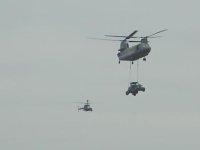Hi all, I have totally hypothetical question if anyone should wish to share their thoughts.
I recently ran across this Navy Asked to Donate Ex. USS Nassau to Support Humanitarian Relief Worldwide | Defense Update: and I think that this is an absolutely fantastic idea for old military equipment.
With this in mind, I was wondering what equipment would one want/need at high altitude, extremely remote disaster sites. I was thinking especially about the recent earthquake in Nepal. All of the pictures I saw showed a bunch of collapsed buildings, bricks and other ruble under which people were very possibly buried. What equipment would anyone think would be the best for moving/excavating debris with the limitation that it had to be airlifted due to the remoteness of the location. A marine V-22 can carry about 15K Lbs in a slung load and this vehicle might serve as a basis for setting limitations on what you could get to the area (also, that 15k load will almost certainly go down as the altitude goes up). I had two thoughts: First, just a plain old bobcat w/ tracks. Second would be something like a JD 3038e (other brands of course perfectly reasonable) with a loader and a backhoe with a thumb (thinking the Wallenstein 620) Neither is a huge machine but that is the point. Also, what other attachments would be desirable in this disaster scenario? A grapple on the loader in place of the bucket? A grapple in addition to the bucket that could be switched out as needed? Some type of accessory to a backhoe? Any other type of attachment I overlooked?
Obviously this is just a hypothetical, but as disasters do happen, I was wondering what "heavy" equipment is light enough, powerful enough and flexible enough to be airlifted (really helicopter lifted) and still actually be useful in the field.
Thanks in advance for insight into my rather eccentric thought,
SI2305
I recently ran across this Navy Asked to Donate Ex. USS Nassau to Support Humanitarian Relief Worldwide | Defense Update: and I think that this is an absolutely fantastic idea for old military equipment.
With this in mind, I was wondering what equipment would one want/need at high altitude, extremely remote disaster sites. I was thinking especially about the recent earthquake in Nepal. All of the pictures I saw showed a bunch of collapsed buildings, bricks and other ruble under which people were very possibly buried. What equipment would anyone think would be the best for moving/excavating debris with the limitation that it had to be airlifted due to the remoteness of the location. A marine V-22 can carry about 15K Lbs in a slung load and this vehicle might serve as a basis for setting limitations on what you could get to the area (also, that 15k load will almost certainly go down as the altitude goes up). I had two thoughts: First, just a plain old bobcat w/ tracks. Second would be something like a JD 3038e (other brands of course perfectly reasonable) with a loader and a backhoe with a thumb (thinking the Wallenstein 620) Neither is a huge machine but that is the point. Also, what other attachments would be desirable in this disaster scenario? A grapple on the loader in place of the bucket? A grapple in addition to the bucket that could be switched out as needed? Some type of accessory to a backhoe? Any other type of attachment I overlooked?
Obviously this is just a hypothetical, but as disasters do happen, I was wondering what "heavy" equipment is light enough, powerful enough and flexible enough to be airlifted (really helicopter lifted) and still actually be useful in the field.
Thanks in advance for insight into my rather eccentric thought,
SI2305

